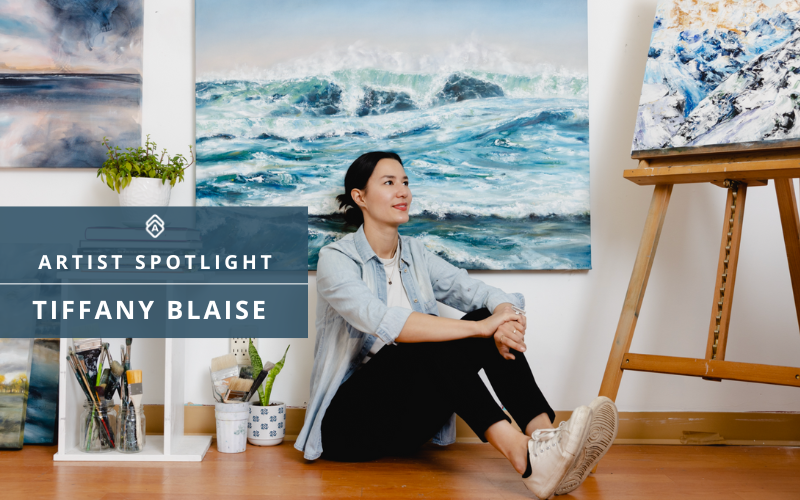“All of my pieces are inspired by dramatic landscapes or seascapes that I’ve either visited or dreamed of.”
That’s the heart of Tiffany Blaise’s work. Artwork Archive's Featured Artist is a Vancouver-based painter who captures the kind of scenery that makes you pause—rugged coasts, swirling skies, places you’ve seen and places you’ve only imagined.
But her paintings go deeper. They’re about the emotional charge behind the landscape. The movement. The introspection.
Using everything from field sketches to palette knives, Blaise builds up layers of texture, ink, and oil to create luminous, mood-driven works. Her paintings are a way to connect—to nature, yes, but also to the parts of ourselves that feel most alive when we’re out in it.
Artwork Archive had the chance to chat with Tiffany Blaise about her creative process, the inspiration behind her work, and how Artwork Archive is her go-to tool.
You can see more of her work on Discovery and learn more about her art practice below:
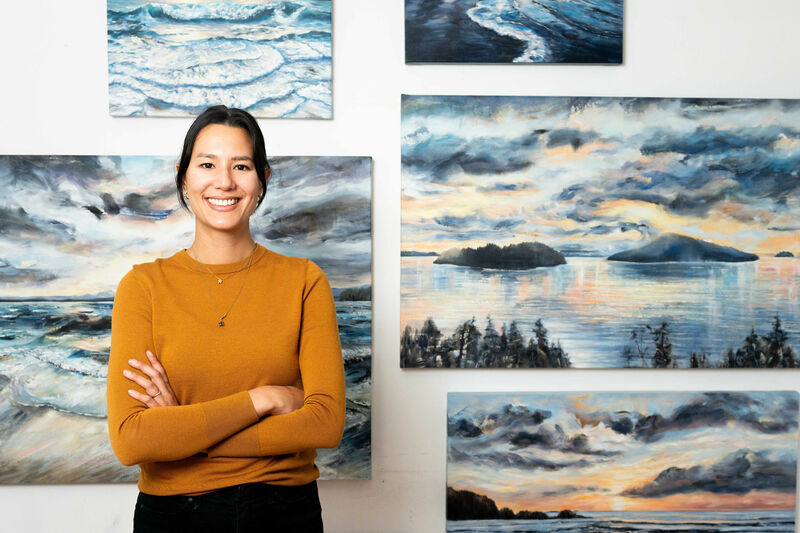
Tiffany Blaise standing in front of a few finished pieces. Photo courtesy of the artist
How Tiffany Blaise Brings Her Landscapes to Life
For artist Tiffany Blaise, inspiration often begins in places where the sky is shifting, the light is changing, and the land or sea feels like it’s holding its breath.
“All of my pieces are inspired by dramatic landscapes or seascapes that I’ve either visited or dreamed of,” she shares. “Places with changing light and elements of transformation—such as an approaching storm or a quickly fading sunset.”
The artist begins each painting in black and white, building structure before emotion. From there, color and texture enter slowly—layered through gesture, ink, and brushwork—until the piece feels alive.
“They start off black and white and transform through thin veils of gestural ink work, brush strokes, colour, and texture!”
Her process mirrors the essence of the landscapes she paints: evolving, layered, and full of movement.
When the Landscape Finds You
Blaise’s compositions are deeply shaped by her travels and spontaneous encounters with nature.
“I am immensely inspired by the places I visit during travels and while adventuring,” she explains. “Some of my favorite places for inspiration are Tofino and the Sea to Sky corridor located in British Columbia, Canada.”
But she doesn’t always go seeking specific views—sometimes, the views find her.
"The best paintings are chance encounters that occur when I’m walking or driving somewhere, looking at a view, and the light or sky is rapidly changing… I could have never planned for it, but these moments are special and strike a chord.”
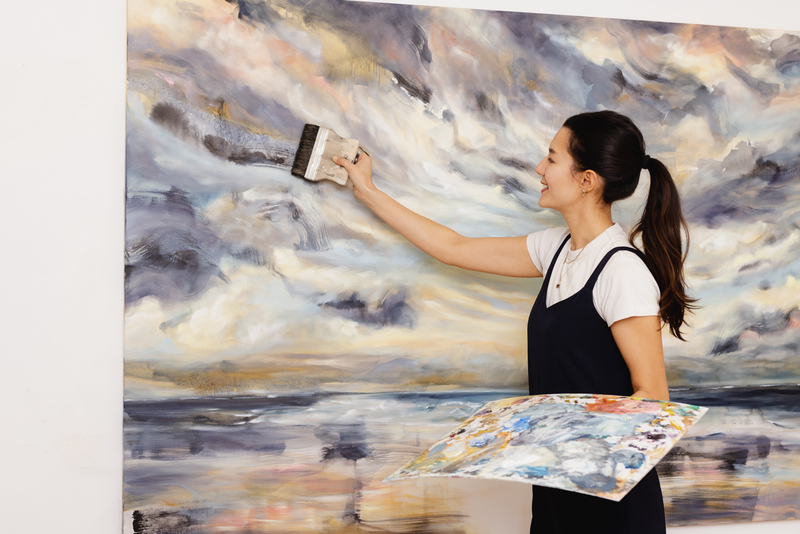
Tiffany Blaise in her studio. Photo courtesy of the artist
The Emotion Behind The Movement
Tiffany Blaise's work often feels like it's in motion—clouds unraveling, waves tumbling, wind rising through trees. And there's a reason for that—she builds her paintings with that sense of movement in mind, allowing emotion to guide the direction.
"I hope viewers feel the movement and life in my art," the artist says. “My landscapes are fueled by emotion, so I hope my work sparks a connection within viewers—to the surrounding natural world as well as their own inner landscape.”
The Mindset That Matters
A thriving art career rarely arrives in a single breakthrough moment. Instead, it grows from quiet, consistent effort—from the days when artists keep showing up, even when it feels like nothing is working.
Tiffany Blaise has learned this over time. She’s also learned how valuable it is to create space for structure inside a creative life—to keep stretching toward the things that feel slightly out of reach.
“I think it's so important for artists to find ways to show up for themselves to grow their practice and career,” Blaise advises, “like getting an art studio, making the effort to network with other artists, and jumping on opportunities that seem exciting but challenging or scary!”
But, she’s careful not to romanticize the process. For her, building a sustainable art career has meant leaning into time, repetition, and trust.
“Embracing the idea that it will most likely take a lot of time, dedication, and hard work to become successful is also important.”
Make Showing Up Easier:
Use Artwork Archive to create structure on the days you don’t feel inspired. On the slower, less creative days where you may not feel like showing up to create, updating your inventory, logging expenses, or searching for artist opportunities can keep you moving forward. Even small actions help build momentum and confidence.
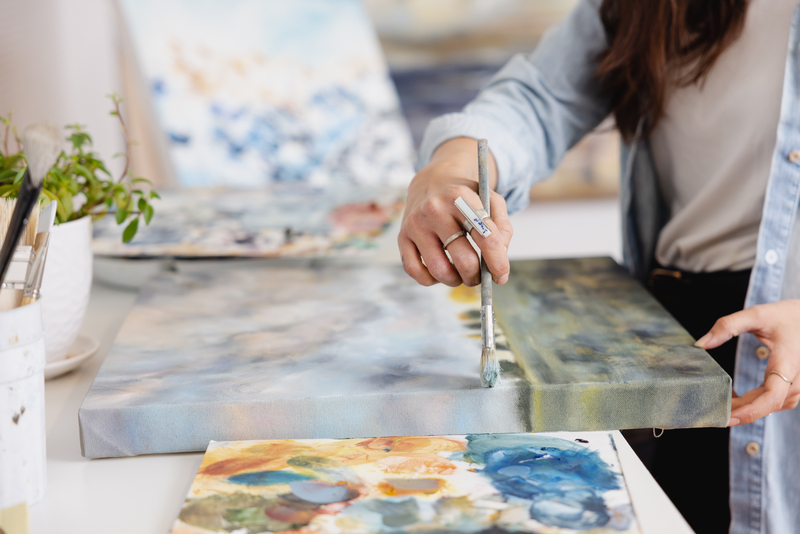
Tiffany Blaise with a WIP, Photo courtesy of the artist
Riding the Waves
One of the most difficult parts of life as an artist, Blaise says, is learning how to handle the slow stretches. When momentum dips and sales aren’t steady, it’s easy to feel discouraged or stuck.
“The biggest challenge for me is the instability and unpredictable nature of being an artist,” she admits. “It's hard to move past feelings of insecurity and defeat when times are tough and sales aren’t rolling through, but I try to remind myself that this is just fear and ego kicking in, and that it all works out at the end of the year.”
These reflections don’t come from a place of perfect resolution—but from experience. From learning to trust the rhythm of her career, knowing that slow moments are part of the natural cycle as an artist, not a sign of failure.
The Moment One Tool Became a Necessity
Like many artists, Tiffany Blaise hit a point where her growing art practice demanded more organization—and a better way to manage all the moving pieces of her business.
“That moment for me occurred when I realized how many paintings I had created and how handy it would be to have a system where I could easily look up my paintings and share them with my clients and galleries.”
After exploring her options, the painter landed on Artwork Archive.
“I decided on Artwork Archive because I found it was super user-friendly and intuitive,” she shares. “It had all of the major features I was hoping to see in an inventory software—including the ability to generate reports and labels, track income and expenses, and even find artist opportunities.”
That one decision transformed the way Blaise runs her art business—freeing up more time for what really matters: making the work.
Give Your Brain a Break:
Let Artwork Archive carry the mental load of remembering titles, prices, and locations. Your brain wasn’t built to remember 300 artwork details. With everything stored in one place, you’ll spend less time hunting for answers—and more time in the studio doing what you love.
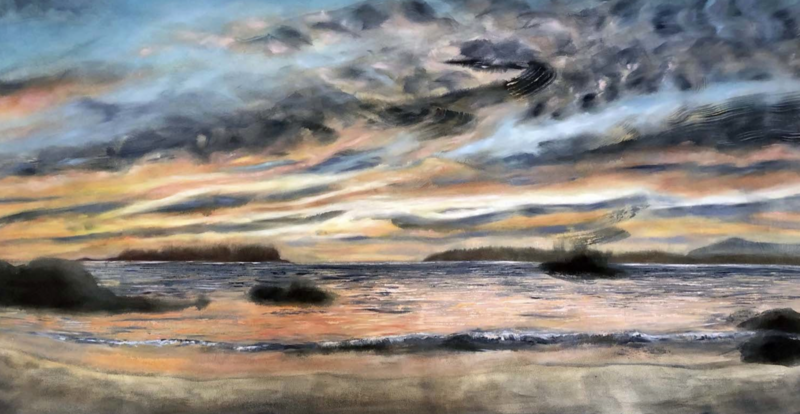
Tiffany Blaise, Ignited Coast, 30 x 60 in, 2021
Catalog Pages That Travel With Her
“I love the ability to generate reports, specifically Catalog Pages on Artwork Archive,” Blaise says.
These customized Catalog Pages have become her go-to resource for art fairs and pop-up shows—especially when she can’t bring her entire inventory.
“This feature makes it easy to create beautiful pages to print off and place in a portfolio binder to share with visitors at art fairs,” she explains. “Since I can’t bring my entire inventory of paintings with me to the show.”
It’s one of those small features that ends up making a big difference—helping her stay polished, professional, and prepared, even in fast-paced event settings.
Reports That Work as Hard as You Do:
Tiffany Blaise keeps things polished at events with Catalog Pages. Want to look just as put-together elsewhere? Use Consignment Reports to document gallery deliveries, Inventory Reports to keep track of what’s in the studio (and what’s sold), and Tear Sheets when a collector wants quick details about a specific series of work.
Let your reports do the heavy lifting so you can stay focused on what really matters—making the work.
Words to Artists Just Getting Started
Tiffany Blaise’s advice to early-career artists is grounded in curiosity, study, and connection.
“I would tell them to try to learn about all kinds of art and art history and go out to look at a lot of art!” she says. “This helps spark ideas and helps develop an eye for observation, which is one of the most vital parts of being a professional artist.”
But just as important as learning from the past is surrounding yourself with creative energy in the present.
“I think it’s important for artists who are in the early stages of their career to begin building a support network of creative peers that they can learn from and share their passion with,” the artist adds. “Community is everything!”
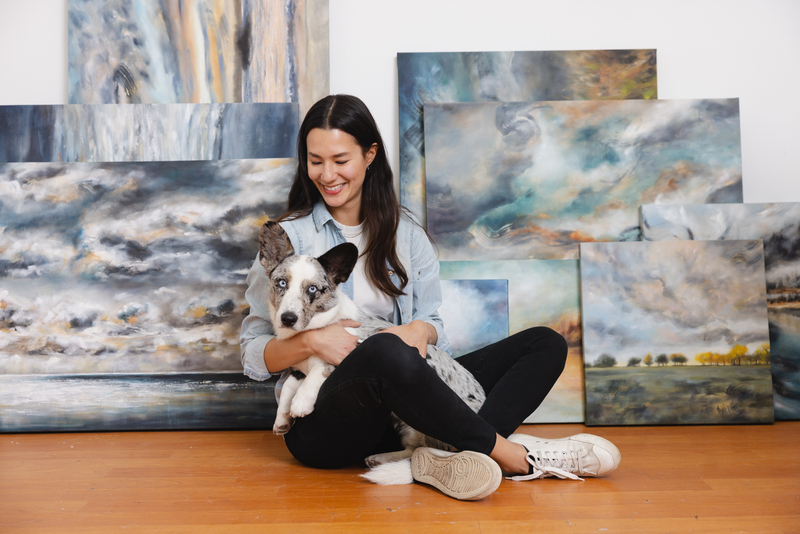
Tiffany Blaise in her studio with her dog. Photo courtesy of the artist
Whether you’re just starting out or years into your practice, getting started with a little organization now saves a lot of stress later—and gives you more time to focus on the work that really matters.
You can make an online portfolio, catalog your artwork, and generate reports like inventory reports, tear sheets, and invoices in seconds with Artwork Archive. Take a look at Artwork Archive's free trial and start growing your art business.
